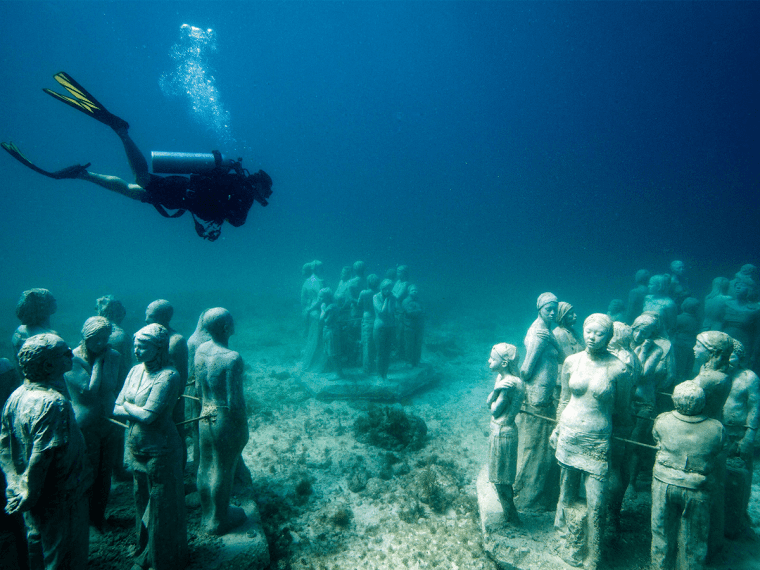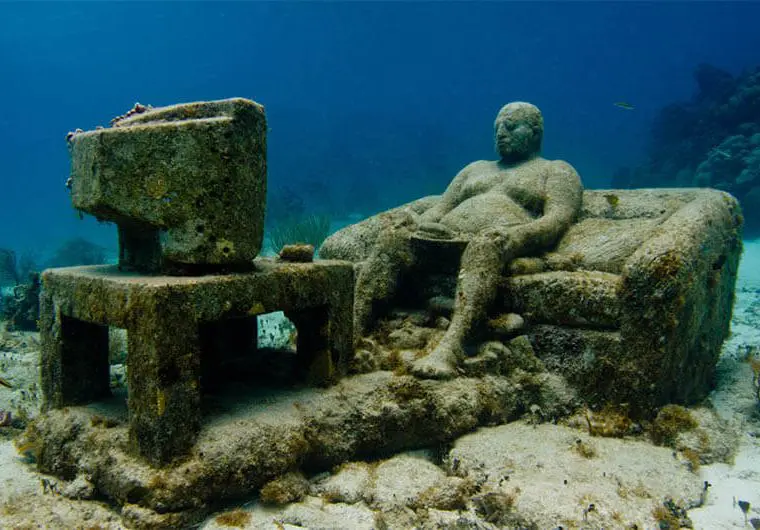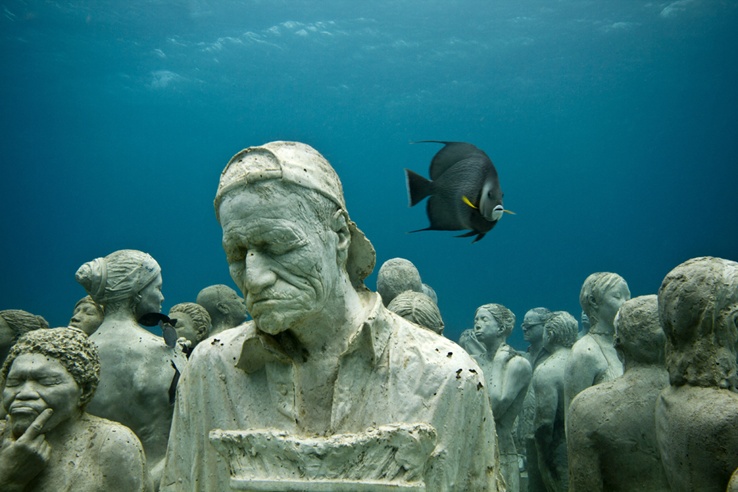Ready to embark on an underwater adventure like no other? Get ready to dive into the enchanting world of Mexico’s underwater sculpture museums. These captivatingly beautiful museums showcase a unique blend of art and marine life, creating an immersive experience that is truly one-of-a-kind. Explore the depths of the ocean and marvel at the intricate sculptures that have been carefully submerged to create underwater galleries. Discover the stunning biodiversity surrounding these submerged masterpieces, as you swim alongside vibrant coral reefs and schools of tropical fish. So grab your scuba gear and prepare to be awe-struck by the breathtaking wonders that await you in Mexico’s underwater sculpture museums.

History of Underwater Sculpture Museums in Mexico
Birth of the Idea
The concept of underwater sculpture museums in Mexico was born out of a desire to combine art with the natural beauty of the marine ecosystem. The idea emerged from the mind of British sculptor Jason deCaires Taylor, who envisioned creating a unique and immersive experience where art could be appreciated underwater. This revolutionary idea would not only showcase breathtaking sculptures but also serve as a platform for promoting marine conservation and raising awareness about the fragile state of coral reefs.
Creation of the First Underwater Sculpture Museum
The first underwater sculpture museum, known as MUSA (Museo Subacuático de Arte), was established off the coast of Cancun, Mexico in 2009. Jason deCaires Taylor collaborated with the National Marine Park of Cancun and the Mexican government to bring his vision to life. The museum features a collection of more than 500 life-sized sculptures, all carefully designed to promote the growth of coral reefs and attract marine life.
Expansion to Other Locations
Following the success of MUSA in Cancun, the concept of underwater sculpture museums expanded to other locations across Mexico. One notable addition was the creation of a museum in Isla Mujeres, an island paradise located just a short distance from Cancun. This museum, known as MUSA Isla Mujeres, features an impressive collection of over 500 sculptures, including replicas of world-renowned artworks.
Artistic Concept and Design
Fusion of Art and Marine Ecosystems
The artistic concept behind underwater sculpture museums in Mexico revolves around the fusion of art and marine ecosystems. Each sculpture is carefully designed to provide a sustainable habitat for marine life, with the aim of promoting the growth of coral reefs and providing a substrate for coral larvae to settle on. The sculptures also serve as a canvas for natural colonization, as they gradually transform with the growth of corals, sponges, and other organisms.
Choosing the Sculptures
The selection of sculptures for underwater museums is a meticulous process. The artists and curators take into consideration the specific needs of marine ecosystems, ensuring that the sculptures provide suitable surfaces for the attachment and growth of corals. The chosen artworks also reflect a range of themes, from human interactions to environmental issues, creating a powerful visual narrative that engages visitors on both an artistic and educational level.
Structural Considerations
When designing the underwater sculptures, structural considerations play a crucial role. The materials used must be environmentally friendly and have minimal impact on the marine environment. The sculptures are carefully engineered to withstand the forces of the water, ensuring they remain intact and safe for both marine life and visitors. Attention is also given to the positioning and arrangement of the sculptures to create an immersive, visually striking experience.
Museum Locations and Highlights
MUSA in Cancun
MUSA in Cancun is the first and largest underwater sculpture museum in Mexico. It features over 500 sculptures spread across several galleries, each with its own unique theme. One of the highlights is “The Silent Evolution” by Jason deCaires Taylor, a stunning display of 400 life-sized statues depicting ordinary people going about their daily lives.
MUSA in Isla Mujeres
MUSA Isla Mujeres, located near the island of Isla Mujeres, offers a diverse collection of underwater sculptures. Notable exhibits include “The Archive of Lost Dreams” by Elier Amado Gil, which portrays a series of doors representing the dreams and aspirations of individuals lost to time.
MUSA in Punta Nizuc
Punta Nizuc is home to another extension of MUSA, featuring a selection of sculptures by various artists. One of the highlights is “Hombre en Llamas” by Roberto Diaz Abraham, an impressive piece depicting a man engulfed in flames, symbolizing the impact of climate change and the destruction it causes.
Cancun Underwater Museum
The Cancun Underwater Museum, located just off the coast of Cancun, showcases the work of Jason deCaires Taylor and other renowned artists. It serves as a platform for cultural preservation, featuring sculptures inspired by Mayan history and Mexican traditions.
Isla Mujeres Underwater Museum
The Isla Mujeres Underwater Museum is another must-visit location. It features sculptures that explore the relationship between humans and the natural world. One notable exhibit is “Anthropocene” by Rodrigo Quiñones Reyes, which depicts a concrete human face slowly becoming covered in coral, symbolizing the impact of human activities on the environment.
Environmental Impact and Conservation
Promoting Coral Reef Restoration
One of the main goals of underwater sculpture museums in Mexico is to promote coral reef restoration. By providing a suitable substrate for coral larvae to settle on, the sculptures encourage the growth of corals, helping to restore damaged or degraded reef systems. Over time, the sculptures become integrated into the natural reef, creating a vibrant and diverse marine ecosystem.
Facilitating Marine Life Colonization
The sculptures in underwater museums not only serve as a habitat for corals but also facilitate the colonization of various marine organisms. Sponges, sea anemones, and other invertebrates find a new home on the sculptures, attracting small fish and crustaceans. This colonization process not only enriches the biodiversity of the area but also provides an opportunity for scientists to study the ecological impact and benefits.
Monitoring and Maintenance Efforts
To ensure the long-term preservation and conservation of the sculptures and their surrounding marine environment, rigorous monitoring and maintenance efforts are undertaken. Regular inspections are conducted to assess the growth and development of the coral reef ecosystem. Any necessary repairs or cleaning activities are carried out to maintain the visual integrity and safety of the sculptures, while maintaining their ecological function.

Diving and Snorkeling Experiences
Diving Certification Requirements
To fully experience the underwater sculpture museums in Mexico, diving certification is required for scuba diving. The museums offer various diving courses and certifications for visitors who wish to explore the sculptures up close. These certifications ensure that visitors have the necessary skills and knowledge to dive safely and responsibly.
Exploring the Museums with Snorkeling
For those who prefer to stay at the surface, snorkeling is an excellent way to explore the underwater sculpture museums. Snorkelers can observe the sculptures from above, enjoying the vibrant colors and marine life that have made the sculptures their home. Snorkeling equipment can be rented on-site or brought from home.
Guided Diving Tours
Guided diving tours are available for visitors who want a more immersive and educational experience. Knowledgeable guides lead divers through the museums, providing insights into the artworks, marine life, and the importance of coral reef conservation. These tours offer a unique perspective on the sculptures, allowing visitors to appreciate the art and learn about the significance of each piece.
Night Dives in the Museums
For a truly magical experience, night dives in the underwater sculpture museums are highly recommended. With the use of underwater lights, the sculptures come alive, casting captivating shadows and mesmerizing patterns on the seafloor. Night dives offer a different perspective on the sculptures and provide a chance to witness the nocturnal behavior of marine life.
Fascinating Sculptures to Discover
Silent Evolution by Jason deCaires Taylor
“The Silent Evolution” by Jason deCaires Taylor is one of the most iconic and captivating sculptures in the underwater sculpture museums. This installation features hundreds of life-sized human figures in various poses, arranged in a formation that resembles a crowd of people. The sculptures gradually transform over time as corals and other organisms colonize and grow on their surfaces, creating a living, evolving artwork.
The Archive of Lost Dreams by Elier Amado Gil
Created by Elier Amado Gil, “The Archive of Lost Dreams” is a thought-provoking sculpture that represents the aspirations and dreams that often go unfulfilled. The installation consists of a row of partially opened doors, each symbolizing a lost dream or forgotten desire. This sculpture serves as a poignant reminder of the fleeting nature of human existence and the preciousness of our dreams.
Hombre en Llamas by Roberto Diaz Abraham
Roberto Diaz Abraham’s “Hombre en Llamas” (Man on Fire) is a striking sculpture that addresses the impact of climate change on our planet. The sculpture depicts a man engulfed in flames, symbolizing the destruction and devastation caused by rising temperatures. It serves as a powerful visual representation of the urgent need to combat climate change and protect our environment.
Anthropocene by Rodrigo Quiñones Reyes
“Anthropocene” by Rodrigo Quiñones Reyes is a sculpture that provokes contemplation about the relationship between humans and the natural world. It features a human face made of concrete slowly becoming covered in coral, illustrating the gradual takeover of nature on man-made structures. This artwork serves as a reminder of the delicate balance between human progress and the preservation of the environment.

Cultural and Educational Significance
Preserving and Sharing Cultural Heritage
Underwater sculpture museums in Mexico play a vital role in preserving and sharing cultural heritage. Many of the sculptures draw inspiration from Mexican culture, traditions, and history. These artworks serve as a tangible connection to the past, allowing visitors to appreciate and learn about Mexico’s rich cultural heritage while exploring the underwater world.
Promoting Awareness of Environmental Issues
A major aim of underwater sculpture museums is to raise awareness about environmental issues, particularly the fragile state of coral reefs. Through the combination of art and marine conservation, these museums provide a unique platform to engage visitors in conversations about the impact of human activities on marine ecosystems. The thought-provoking sculptures prompt reflection and inspire action towards environmental stewardship.
Educating Visitors on Marine Ecosystems
Underwater sculpture museums not only captivate visitors with their artistic beauty but also provide an educational experience. Visitors learn about the importance of coral reefs, their role in supporting marine life, and the threats they face. The museums also showcase the power of art to inspire change and offer insight into the efforts being made to protect and restore coral reefs.
Inspiration for Future Underwater Museums
Potential Museum Locations
The success of underwater sculpture museums in Mexico has inspired other coastal regions around the world to consider establishing their own underwater museums. Potential locations include the Caribbean, Southeast Asia, and the Mediterranean, where vibrant marine ecosystems and a rich cultural heritage can be celebrated and preserved.
Artistic Collaborations and Themes
Future underwater museums may explore artistic collaborations and themes that reflect the unique cultural and environmental characteristics of their respective regions. Collaborations between local artists, sculptors, and marine biologists could create thought-provoking installations that address regional environmental issues, cultural heritage, and social narratives.
Advancements in Underwater Museum Technology
Advancements in underwater museum technology are likely to shape the future of this unique form of art. Technological innovations, such as virtual reality experiences and underwater cameras, could enhance visitor engagement and allow for exploration of underwater sculptures without the need for diving or snorkeling. These advancements may also offer new opportunities for research and conservation efforts.
Planning Your Visit
Best Time to Visit
The underwater sculpture museums in Mexico can be visited year-round, as the warm Caribbean waters provide ideal conditions for diving and snorkeling. However, the peak tourist season in Mexico is from December to April, so visitors may prefer to plan their trip during the quieter months of May to November for a more serene and intimate experience.
Choosing a Museum Location
With multiple underwater sculpture museums in Mexico, visitors have the opportunity to explore different locations and experiences. For those looking for a vibrant and expansive collection, MUSA in Cancun is a fantastic choice. If a more intimate setting is desired, MUSA Isla Mujeres offers a diverse collection in a tranquil island setting. Punta Nizuc is also a great option for its unique sculptures and stunning underwater landscapes.
Entrance Fees and Opening Hours
Entrance fees and opening hours vary for each underwater sculpture museum. It is advisable to check the official websites or contact the museums directly for the most up-to-date information. Some museums offer discounted rates for local residents, students, and groups, while others may have special packages that include equipment rental and guided tours.
Equipment Rental and Safety Precautions
Visitors who plan to dive or snorkel at the underwater sculpture museums can typically rent equipment on-site. Dive centers and shops located near the museums offer a range of rental options, including wetsuits, masks, fins, and diving gear. Safety should always be a priority, and visitors must follow the instructions of trained professionals, adhere to diving guidelines, and take necessary precautions to ensure a safe and enjoyable experience.
Conclusion
Mexico’s underwater sculpture museums are more than just unique attractions; they are artistic testaments to the beauty and fragility of the marine world. Through their fusion of art and marine conservation, these museums bring together culture, environment, and education in a captivating and immersive experience. As visitors explore the underwater galleries, they are not only enchanted by the sculptures but also reminded of the urgency to preserve and protect our oceans. Whether you are an art lover, a scuba diving enthusiast, or someone passionate about marine conservation, a visit to Mexico’s underwater sculpture museums promises an unforgettable journey into a world where art and nature intertwine in breathtaking harmony.

